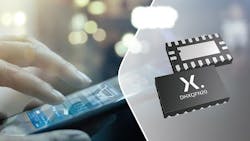Standard Logic Squeezes into the Smallest, Thinnest Packages
Nexperia unveiled a comprehensive family of standard logic elements housed in the DHXQFN form factor—the smallest and lowest-profile 14-, 16-, 20-, and 24-pin packages. Since we tend to focus on the MCUs and ASICs at the core of most embedded systems, it's easy to forget the important roles that humble standard logic elements play in many designs. But it's also easy to see how useful these space-saving components will be in small-form-factor systems.
For example, the 16-pin DHXQFN package is 45% smaller than the industry-standard DQFN16 leadless device. In addition to its reduced volume, the new package's smaller footprint offers a 25% saving in PCB area. The DHXQFN's small footprint also allows the elements to be placed closer to a bypass capacitor. On top of the fact that it’s now easier to fit glue logic into designs with limited board space, the shorter traces between the device and the capacitor results in increased performance in high-frequency applications.
Measuring just 2 × 2 mm (14 pin), 2 × 2.4 mm (16 pin), 2 × 3.2 mm (20 pin) and 2 × 4 mm (24 pin), the 0.4-mm-pitch DHXQFN packages are a mere 0.45 mm high. The parts include hex inverting Schmitt-triggers; 8-bit serial-in, parallel-out (SIPO) shift registers with output latches; 4-bit dual-supply translating transceivers; octal buffer/line drivers; octal bus transceivers; and 8-bit dual-supply translating transceivers.
About the Author
Lee Goldberg
Contributing Editor
Lee Goldberg is a self-identified “Recovering Engineer,” Maker/Hacker, Green-Tech Maven, Aviator, Gadfly, and Geek Dad. He spent the first 18 years of his career helping design microprocessors, embedded systems, renewable energy applications, and the occasional interplanetary spacecraft. After trading his ‘scope and soldering iron for a keyboard and a second career as a tech journalist, he’s spent the next two decades at several print and online engineering publications.
Lee’s current focus is power electronics, especially the technologies involved with energy efficiency, energy management, and renewable energy. This dovetails with his coverage of sustainable technologies and various environmental and social issues within the engineering community that he began in 1996. Lee also covers 3D printers, open-source hardware, and other Maker/Hacker technologies.
Lee holds a BSEE in Electrical Engineering from Thomas Edison College, and participated in a colloquium on technology, society, and the environment at Goddard College’s Institute for Social Ecology. His book, “Green Electronics/Green Bottom Line - A Commonsense Guide To Environmentally Responsible Engineering and Management,” was published by Newnes Press.
Lee, his wife Catherine, and his daughter Anwyn currently reside in the outskirts of Princeton N.J., where they masquerade as a typical suburban family.
Lee also writes the regular PowerBites series.

